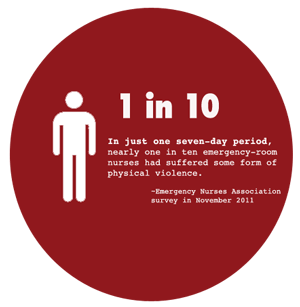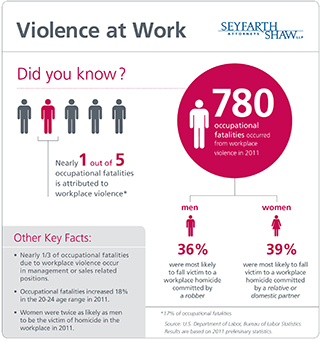by Jane Slaughter
April 21, 2015
In a society filled with violence–from unpunished police officers to killings by mentally ill people with access to firearms–there’s also an epidemic of criminal assaults on workers at their job sites each year, which mostly will go unpunished, even unreported and unremarked, unless a perpetrator “goes postal” with a shooting spree. Workplace violence ranges from threats and curses to murder.  Spitting on bus drivers is so common in New York City that their union won them DNA kits last year, to collect saliva.
Spitting on bus drivers is so common in New York City that their union won them DNA kits last year, to collect saliva.
A study covering 7,169 emergency room nurses found that 43% had been verbally abused by a patient or visitor just in the previous week, one percent were physically abused, and 11% were both physically and verbally abused. For women, homicide is the leading cause of death on the job. It is the fourth-highest cause of workplace death overall, with 463 workplace homicides in 2012. Even the normally terse Bureau of Labor Statistics remarks that “workplace violence can strike anywhere, anytime, and no one is immune.” Government agencies say that workplace violence is on the decline, but for certain categories of workers, it doesn’t feel that way.
Two bus drivers’ unions held a conference in 2011 “responding to the recent massive increase in violence against transit operators.” The Department of Transportation held a summit on bus violence last year including unions, police chiefs, bus manufacturers, and agency heads. Asked if the problem were getting worse, President Larry Hanley of the Amalgamated Transit Union ticked off three incidents just in the previous couple of weeks: a driver slashed in the face, another held up at gunpoint, a woman driver punched in the breast.
Bus drivers and nurses fit the profile of workers that Occupational Safety and Health Administration (OSHA) says are at highest risk, those who:
- exchange money with the public;
- provide services or care;
- work with volatile, unstable people;
- work alone or in isolated areas;
- work where alcohol is served, or;
- work at night or in high-crime areas.
Likely to Get Worse
Attacks by members of the public on workers who are just doing their jobs can be laid at the feet of governments who are cutting budgets and making services worse in every way. The Emergency Nurses Association writes, “Violence in the emergency department is likely to rise with the ongoing nursing shortage, crowding issues and longer waiting times.” Hanley sees angry riders reacting to higher fares and less frequent service: and it’s the drivers who “have to go out and collect taxes in the community.”
Steve Downs of the Transport Workers Union in New York says, “If your train is late, if you’re pissed off, you can’t take it out on the CEO” of the system. But you can take it out on a transit worker. Jeff Weber, a nurse at a public psychiatric hospital in Wisconsin, says that as the facility closed its long-term care unit, caregivers worked short-staffed for months. “There were challenges every day,” he said, citing an incident where a patient smashed five windows with a chair and threatened to kill workers. “We’ve transferred a gentleman from here to a jail because he was injuring staff,” Weber recalled. “They kicked him out of jail and sent him back because he injured two guards.”
Of course, as at the psychiatric hospital, not all violence is caused by cutbacks. Patients, hotel guests, transit riders, bar patrons, students, airline passengers bring their own problems into the public sphere, from domestic disputes to lack of a job to mental illness to sexual entitlement.
The tragedy of a system set up on scarcity, which treats public services as a zero-sum game, is that workers who serve the public can come to see that public as the enemy–and vice versa. The caseworker starts to see clients as gaming the system; the impoverished mother denied a benefit has no one to lash out at but her “worker.” “It seems like a simple idea,” says Downs, “that we are public servants, providing a valuable service–we shouldn’t be beat up in the performance of our duties.”
Employers Who Don’t Care
Managements have many motivations for turning a blind eye to workplace violence. One is cost. It isn’t that expensive to install a Plexiglas shield around a bus driver, but any cost is seen as too high when budgets are shrinking. A redesigned bus of a type sometimes seen in Europe, where the driver has an escape door on his or her left, is out of the question. Security guards, training in defusing volatile situations, personal alarm systems: all cost money that agencies are loathe to spend. But the biggest cost that management seeks to avoid is adequate staffing, which would boost safety two ways: better service and keeping employees from working alone.
Karine Raymond, an emergency nurse in New York, says simply, “People get angry when there aren’t enough staff and their needs are not being met.” At Raymond’s Montefiore Weiler hospital, the Labor and Delivery department has been squeezing two mothers into a room meant for one. Some fathers act out. “They staff very, very leanly, they have ‘lean committees,’” Raymond said. “It’s all about skimpily and scantily.” Despite a union campaign that generated 128 “protests of assignment” with 852 signatures, management was not forthcoming about adding nurses, or security staff.
Steve Schrag does health and safety work at another New York hospital. The biggest risk for attack is working alone, he says, “the same as for a bodega worker or a taxi driver.” Citing a Brooklyn case where a nurse was kicked in the head and left in a coma, Schrag said, “Another set of eyes and ears–if she hadn’t been alone, she would have been attacked but not as seriously.” Yet Schrag enters union discussions with management with the “presumption we won’t get full staffing, which would be the most important thing.” A hotel workers’ union staffer says she knows of no hotel where housekeepers clean rooms in pairs, even though that step would not seem to increase the number of workers needed.
A second reason for management apathy is prioritization of customers, who pay the bills, over workers, who are a bill. Hotels coddle frequent travelers, bar managers encourage waitresses to show a little skin. Debbie White, a nurse in New Jersey, tells of a hospital visitor whose family member, the patient, had a restraining order against him. When he threatened a nurse, he was escorted out, but later allowed back in. “They said he had a right to see the patient,” White said. “The Medicare regs say you have to have patient satisfaction or you don’t get reimbursed.”
Management ignores violence in order to protect its institutional reputation, and individual managers want to look good to their superiors. Chicago teacher Jerry Skinner says administrators at his high school changed their procedures for reporting incidents, to produce a drop from 2900 to 1100. Also at stake is workplace control. Managements “don’t even want to have the discussion with the union,” says Schrag. “They don’t want to acknowledge that the union has a good idea”–an attitude rooted in the basic truth of employers’ attitude toward workers.
“Their tolerance toward members being hurt is really not much different from 100 years ago,” Schrag says, perhaps thinking of the Triangle Shirtwaist fire that gave the first big boost to workplace safety laws. “Workers are replaceable parts, so they don’t see any particular reason to care about a particular worker getting injured.” “Levels of stress are at a breaking point in our society,” Schrag adds. “If you’re worried about how you’re going to pay the bills, stress goes up. Two hours in a waiting room, your stress levels go up.”
Workers are left to deal not just with bosses’ on-the-job pressure to boost profits or adapt to straitened budgets. They’re left to pick up the pieces, even of their co-workers’ bodies, when pressures on human beings lead to an explosion.
Jane Slaughter is a member of Solidarity and a longtime activist and writer in the labor movement. She recently retired as co-director of Labor Notes.

